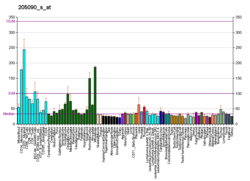Protein-coding gene in the species Homo sapiens
| NAGPA |
|---|
|
| Identifiers |
|---|
| Aliases | NAGPA, Nagpa, AI596180, UCE, APAA, N-acetylglucosamine-1-phosphodiester alpha-N-acetylglucosaminidase |
|---|
| External IDs | OMIM: 607985; MGI: 1351598; HomoloGene: 8466; GeneCards: NAGPA; OMA:NAGPA - orthologs |
|---|
| Gene location (Human) |
|---|
 | | Chr. | Chromosome 16 (human)[1] |
|---|
| | Band | 16p13.3 | Start | 5,024,844 bp[1] |
|---|
| End | 5,034,141 bp[1] |
|---|
|
| Gene location (Mouse) |
|---|
 | | Chr. | Chromosome 16 (mouse)[2] |
|---|
| | Band | 16|16 A1 | Start | 5,013,153 bp[2] |
|---|
| End | 5,021,876 bp[2] |
|---|
|
| RNA expression pattern |
|---|
| Bgee | | Human | Mouse (ortholog) |
|---|
| Top expressed in | - middle temporal gyrus
- Brodmann area 10
- oocyte
- Brodmann area 9
- secondary oocyte
- Brodmann area 23
- monocyte
- cingulate gyrus
- nucleus accumbens
- superior frontal gyrus
|
| | Top expressed in | - interventricular septum
- yolk sac
- submandibular gland
- lip
- esophagus
- morula
- proximal tubule
- thymus
- stomach
- placenta
|
| | More reference expression data |
|
|---|
| BioGPS |  | | More reference expression data |
|
|---|
|
| Gene ontology |
|---|
| Molecular function | - N-acetylglucosamine-1-phosphodiester alpha-N-acetylglucosaminidase activity
- hydrolase activity
- protein binding
| | Cellular component | - integral component of membrane
- Golgi cisterna membrane
- Golgi apparatus
- membrane
- integral component of plasma membrane
| | Biological process | - protein glycosylation
- protein targeting to lysosome
- lysosome organization
- secretion of lysosomal enzymes
- carbohydrate metabolic process
| | Sources:Amigo / QuickGO |
|
| Orthologs |
|---|
| Species | Human | Mouse |
|---|
| Entrez | | |
|---|
| Ensembl | | |
|---|
| UniProt | | |
|---|
| RefSeq (mRNA) | | |
|---|
| RefSeq (protein) | | |
|---|
| Location (UCSC) | Chr 16: 5.02 – 5.03 Mb | Chr 16: 5.01 – 5.02 Mb |
|---|
| PubMed search | [3] | [4] |
|---|
|
| Wikidata |
| View/Edit Human | View/Edit Mouse |
|
N-acetylglucosamine-1-phosphodiester alpha-N-acetylglucosaminidase is an enzyme that in humans is encoded by the NAGPA gene.[5][6][7]
Hydrolases are transported to lysosomes after binding to mannose 6-phosphate receptors in the trans-Golgi network. This gene encodes the enzyme that catalyzes the second step in the formation of the mannose 6-phosphate recognition marker on lysosomal hydrolases. Commonly known as 'uncovering enzyme' or UCE, this enzyme removes N-acetyl-D-glucosamine (GlcNAc) residues from GlcNAc-alpha-P-mannose moieties and thereby produces the recognition marker. This reaction most likely occurs in the trans-Golgi network. This enzyme functions as a homotetramer of two disulfide-linked homodimers. In addition to having an N-terminal signal peptide, the protein's C-terminus contains multiple signals for trafficking it between lysosomes, the plasma membrane, and trans-Golgi network.[7]
To date, the only disorder in humans associated with this gene is Persistent Neurodevelopmental Stuttering (PNdS).[8]
References
- ^ a b c GRCh38: Ensembl release 89: ENSG00000103174 – Ensembl, May 2017
- ^ a b c GRCm38: Ensembl release 89: ENSMUSG00000023143 – Ensembl, May 2017
- ^ "Human PubMed Reference:". National Center for Biotechnology Information, U.S. National Library of Medicine.
- ^ "Mouse PubMed Reference:". National Center for Biotechnology Information, U.S. National Library of Medicine.
- ^ Kornfeld R, Bao M, Brewer K, Noll C, Canfield W (Jan 2000). "Molecular cloning and functional expression of two splice forms of human N-acetylglucosamine-1-phosphodiester alpha-N-acetylglucosaminidase". J Biol Chem. 274 (46): 32778–85. doi:10.1074/jbc.274.46.32778. PMID 10551838.
- ^ Do H, Lee WS, Ghosh P, Hollowell T, Canfield W, Kornfeld S (Aug 2002). "Human mannose 6-phosphate-uncovering enzyme is synthesized as a proenzyme that is activated by the endoprotease furin". J Biol Chem. 277 (33): 29737–44. doi:10.1074/jbc.M202369200. PMID 12058031.
- ^ a b "Entrez Gene: NAGPA N-acetylglucosamine-1-phosphodiester alpha-N-acetylglucosaminidase".
- ^ Lee, W. S.; Kang, C.; Drayna, D.; Kornfeld, S. (2011). "Analysis of mannose 6-phosphate uncovering enzyme mutations associated with persistent stuttering". The Journal of Biological Chemistry. 286 (46): 39786–93. doi:10.1074/jbc.M111.295899. PMC 3220557. PMID 21956109.
Further reading
- Lee JK, Pierce M (1995). "Purification and characterization of human serum N-acetylglucosamine-1-phosphodiester alpha-N-acetylglucosaminidase". Arch. Biochem. Biophys. 319 (2): 413–25. doi:10.1006/abbi.1995.1312. PMID 7786023.
- Andersson B, Wentland MA, Ricafrente JY, et al. (1996). "A "double adaptor" method for improved shotgun library construction". Anal. Biochem. 236 (1): 107–13. doi:10.1006/abio.1996.0138. PMID 8619474.
- Page T, Zhao KW, Tao L, Miller AL (1997). "Purification and characterization of human lymphoblast N-acetylglucosamine-1-phosphodiester alpha-N-acetylglucosaminidase". Glycobiology. 6 (6): 619–26. doi:10.1093/glycob/6.6.619. PMID 8922957.
- Yu W, Andersson B, Worley KC, et al. (1997). "Large-scale concatenation cDNA sequencing". Genome Res. 7 (4): 353–8. doi:10.1101/gr.7.4.353. PMC 139146. PMID 9110174.
- Rohrer J, Kornfeld R (2001). "Lysosomal hydrolase mannose 6-phosphate uncovering enzyme resides in the trans-Golgi network". Mol. Biol. Cell. 12 (6): 1623–31. doi:10.1091/mbc.12.6.1623. PMC 37329. PMID 11408573.
- Lee WS, Rohrer J, Kornfeld R, Kornfeld S (2002). "Multiple signals regulate trafficking of the mannose 6-phosphate-uncovering enzyme". J. Biol. Chem. 277 (5): 3544–51. doi:10.1074/jbc.M108531200. PMID 11723124.
- Strausberg RL, Feingold EA, Grouse LH, et al. (2003). "Generation and initial analysis of more than 15,000 full-length human and mouse cDNA sequences". Proc. Natl. Acad. Sci. U.S.A. 99 (26): 16899–903. Bibcode:2002PNAS...9916899M. doi:10.1073/pnas.242603899. PMC 139241. PMID 12477932.
- Ota T, Suzuki Y, Nishikawa T, et al. (2004). "Complete sequencing and characterization of 21,243 full-length human cDNAs". Nat. Genet. 36 (1): 40–5. doi:10.1038/ng1285. PMID 14702039.
- Gerhard DS, Wagner L, Feingold EA, et al. (2004). "The status, quality, and expansion of the NIH full-length cDNA project: the Mammalian Gene Collection (MGC)". Genome Res. 14 (10B): 2121–7. doi:10.1101/gr.2596504. PMC 528928. PMID 15489334.
- Nair P, Schaub BE, Huang K, et al. (2005). "Characterization of the TGN exit signal of the human mannose 6-phosphate uncovering enzyme". J. Cell Sci. 118 (Pt 13): 2949–56. doi:10.1242/jcs.02434. PMID 15976452.



















